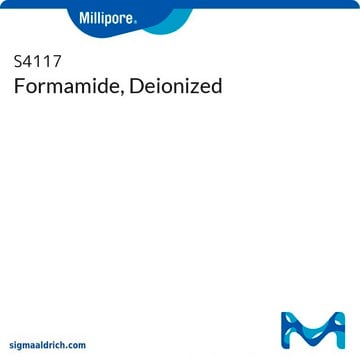F7503
Formamide
ReagentPlus®, ≥99.0% (GC)
Synonym(s):
Amide C1, Formic amide
About This Item
Recommended Products
vapor density
1.55 (vs air)
vapor pressure
0.08 mmHg ( 20 °C)
30 mmHg ( 129 °C)
product line
ReagentPlus®
Assay
≥99.0% (GC)
form
liquid
autoignition temp.
932 °F
expl. lim.
2.7-19 %
technique(s)
hybridization: suitable
refractive index
n20/D 1.447 (lit.)
pH
4-10 (20 °C, 200 g/L)
bp
210 °C (lit.)
mp
2-3 °C (lit.)
density
1.134 g/mL at 25 °C (lit.)
SMILES string
NC=O
InChI
1S/CH3NO/c2-1-3/h1H,(H2,2,3)
InChI key
ZHNUHDYFZUAESO-UHFFFAOYSA-N
Looking for similar products? Visit Product Comparison Guide
Related Categories
General description
Application
- To synthesize tetrakis(trialkylsilyl) diphosphate by reacting disodium dihydrogen diphosphate with trialkyl chlorosilane.
- In Cu/C catalyzed cycloaddition between azides and terminal alkynes to synthesize triazoles.
Legal Information
Signal Word
Danger
Hazard Statements
Precautionary Statements
Hazard Classifications
Carc. 2 - Repr. 1B - STOT RE 2 Oral
Target Organs
Blood
Storage Class Code
6.1C - Combustible acute toxic Cat.3 / toxic compounds or compounds which causing chronic effects
WGK
WGK 1
Flash Point(F)
305.6 °F
Flash Point(C)
152 °C
Regulatory Listings
Regulatory Listings are mainly provided for chemical products. Only limited information can be provided here for non-chemical products. No entry means none of the components are listed. It is the user’s obligation to ensure the safe and legal use of the product.
PRTR
Class II Designated Chemical Substances
FSL
Group 4: Flammable liquids
Type 3 petroleums
Hazardous rank III
Water soluble liquid
ISHL Indicated Name
Substances Subject to be Indicated Names
ISHL Notified Names
Substances Subject to be Notified Names
JAN Code
F7503-500ML:4548173196886
F7503-250ML:4548173196879
F7503-5ML:4548173196893
F7503-2.5L:4548173196862
F7503-VAR:
F7503-100ML:4548173196848
F7503-BULK:
F7503-4L:4548173925332
F7503-1L:4548173196855
F7503-2L:
F7503-6X100ML:4548173196909
Certificates of Analysis (COA)
Search for Certificates of Analysis (COA) by entering the products Lot/Batch Number. Lot and Batch Numbers can be found on a product’s label following the words ‘Lot’ or ‘Batch’.
Already Own This Product?
Find documentation for the products that you have recently purchased in the Document Library.
Our team of scientists has experience in all areas of research including Life Science, Material Science, Chemical Synthesis, Chromatography, Analytical and many others.
Contact Technical Service



